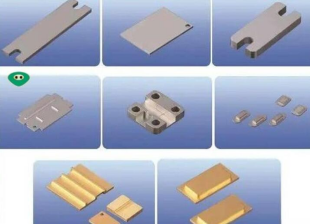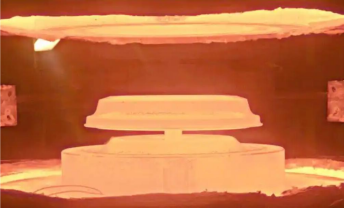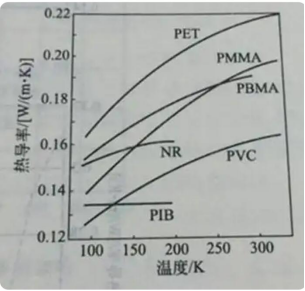ABOUT
An alysis of the Outstanding Performance of Molybdenum-Copper Alloy and CMC Three-Layer Structure Materials
Analysis of the Outstanding Performance of Molybdenum-Copper Alloy and CMC Three-Layer Structure Materials

1. Molybdenum-Copper Alloy Properties and Applications
Molybdenum-copper alloy, a pseudo-alloy crafted from two non-intersoluble metals, not only combines the unique properties of molybdenum and copper but also exhibits exceptional material properties. Its high thermal conductivity ensures efficient heat dissipation; its coefficient of thermal expansion can be flexibly adjusted to meet diverse requirements. Furthermore, its non-magnetic properties, low gas content, and excellent vacuum performance enable stable operation in a wide range of environments. Its excellent machinability and exceptional high-temperature performance make it a shining example in various industrial fields, including machinery, electrical power, electronics, and metallurgy.

1.1 ► Diverse Applications
The high thermal conductivity, low coefficient of thermal expansion, and non-magnetic properties of molybdenum-copper alloy make it an excellent choice for applications in electronics and machinery. Its applications include heat dissipation materials for power amplifiers, the construction and maintenance of radio base stations, the manufacture of arcing and vacuum contacts for high- and medium-voltage switches or circuit breakers, heat dissipation components in electronic equipment, electrode materials in resistance welding processes, and the development and application of electronic packaging and heat sink materials. It excels in optimizing IGBT modules for electric vehicle (EV/HEV) engines and manufacturing high-performance lead frames. It can also be used in the design and manufacture of thermal control panels and heat sinks for military and civilian applications.
1.2 ► Product Specifications and Performance Parameters
Molybdenum-copper alloys of various grades and proportions exhibit specific density, thermal conductivity, and thermal expansion coefficients. Mo85Cu15 to Mo50Cu50 exhibit excellent material properties at room to high temperatures. The following are some typical performance parameters:
| Grade | Molybdenum Content (Wt%) | Copper Content (Wt%) | Density (g/cm³) | Thermal Conductivity (W/(M·K)) | Coefficient of Thermal Expansion (10-6/K) |
|——-|————–|————–|————–|——————|———————|
| Mo85Cu15 | 85±1 | Balance | 10.160–1.80 | 6.8 | 6.8 |
| Mo80Cu20 | 80±1 | Balance | 9.9 | 170–190 | 7.7 |
| Mo70Cu30 | 70±1 | Balance | 9.8 | 180–200 | 9.1 |
| Mo60Cu40 | 60±1 | Balance | 9.66 | 210–250 | 10.3 |
| Mo50Cu50 | 50 ±0.2 | Balance | 9.54 | 230–270 | 11.5 |
2. CMC Three-Layer Material Performance
2.1 ► Material Design and Advantages
CMC (copper-molybdenum-copper) three-layer material, with its unique layered design and superior performance, is an ideal replacement for high-power electronic components. Its low coefficient of thermal expansion and high thermal conductivity are key advantages in the material design. Its core material is made of molybdenum-copper or molybdenum, with copper layers on both sides. This not only offers a low coefficient of thermal expansion but also significantly improves thermal conductivity compared to WCu and MoCu, providing a highly efficient cooling solution for high-power components such as IGBT modules.
2.2 ► Key Performance Indicators
When exploring the unique characteristics of CMC (copper-molybdenum-copper) three-layer material, we further examined the thermal conductivity and coefficient of thermal expansion of different materials. The superiority of these key performance indicators is crucial for understanding CMC as an ideal replacement for high-power components such as IGBT modules. Compared to materials such as WCu and MoCu, CMC’s superior thermal conductivity strongly supports its application in efficient cooling solutions. Furthermore, its low coefficient of thermal expansion enables CMC to maintain stable performance even in high-temperature environments, further broadening its application range.

2.3 ► Material Thermal Conductivity Data
The thermal conductivity of various CMC materials was measured at 20°C, expressed in [W/(m·K)]. The thermal conductivity data for Mo-Cu alloys with varying ratios demonstrates the excellent thermal properties of CMC materials under varying temperature conditions. Specific data are as follows: the thermal conductivity of MoCu30 (Mo-30% Cu) is 9.7±0.2, WCu10 (W-10% Cu) is 17.1±0.4, WCu15 (W-15% Cu) is 16.8±0.4, and WCu20 (W-20% Cu) is 15.6±0.4. We also provide the thermal conductivity range for Cu/Mo-30Cu/Cu (CPC). These data provide a valuable insight into the thermal properties of CMC materials.
At a 1:4:1 ratio, the thermal conductivity of Mo-52%Cu is 9.4±0.2, with a thermal conductivity range of 7.2-9. Furthermore, we measured the thermal conductivity at 340° in-plane and 300° thick, and also provide the thermal conductivity of the Cu/Mo/Cu (CMC) composite. These data further expand our understanding of the thermal properties of CMC materials. Through these detailed thermal conductivity data, we can more comprehensively understand the performance of CMC materials under different application conditions.
Keyword:
Molybdenum-Copper Alloy、Molybdenum Mo85Cu15、Mo80Cu20、Mo70Cu30、Mo60Cu40、Mo50Cu50:CMC (copper-molybdenum-copper、MoCu30 (Mo-30% Cu) 、Mo-52%Cu
We Exist to Make Your Projects Successful
Fill out the form below and someone from our team will be in touch with you!
FOTMA Delivers Professional Ultra-Dense Solutions, Lighter on Cost, Heavier on Performance.
Hubei Fotma Machinery Co. Ltd.
Wechat / Whatsapp / Mobile:
+86 13995656368, +86 13907199894
Tel: +86-27-67845266
Email: bunny@fotma.com, export@fotma.com
Address: Guanggu Avenue 52#, Hongshan, Wuhan,
Hubei province, P.R.China. 430074